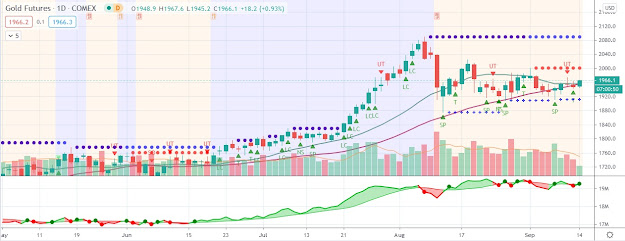gold price climbed $7.10 to $1,523 Wednesday after China raised interest rates
 The gold price climbed $7.10 to $1,523 Wednesday after China raised interest rates for the third time this year. The price of gold fell as low as $1,510 per ounce before bouncing back above $1,520 after the People’s Bank of China announced that the one-year lending rate will rise to 6.56% from 6.31%, effective tomorrow. Commodities, notably copper – lower by 0.8% to $4.32 per pound – fell across the board on concerns that China’s fight to stamp out inflation will weigh on its growth rate.
The gold price climbed $7.10 to $1,523 Wednesday after China raised interest rates for the third time this year. The price of gold fell as low as $1,510 per ounce before bouncing back above $1,520 after the People’s Bank of China announced that the one-year lending rate will rise to 6.56% from 6.31%, effective tomorrow. Commodities, notably copper – lower by 0.8% to $4.32 per pound – fell across the board on concerns that China’s fight to stamp out inflation will weigh on its growth rate. Next week, China’s statistics bureau will release the nation’s consumer price inflation data – expected to climb to over 6%. The pre-emptive move interest rate hike led to fears that the spike in prices, notably for food, could exceed analyst estimates. The euro sank against the U.S. dollar, dropping to 1.43 while S&P 500 equity futures declined 6.80 to 1329.90.
Erste Group went on to discuss the significant impact of monetary policies on the gold price over the past decade. Since 2007, the Federal Reserve, European Central Bank (ECB), and the Bank of England have expanded their balance sheets by over $4.5 trillion. While that amount has helped fuel the gold price advance – according to the firm – of further significance is the fact that real interest rates have remained in negative territory for 47% of the time since 2000. Based on historical data, Erste determined that the gold price has on average gained close to 20% per year when real interest rates are in negative territory.
As for those who believe the gold price has reached bubble territory, Erste Group noted in spite of its rise over the past decade, gold currently only accounts for approximately 1% of global financial assets. Furthermore, the gold analyst community remains particularly cautious in its gold price forecasts. According to Bloomberg, the median gold price estimate for 2012, 2013, and 2014 are $1,400, $1,231, and $1,159 per ounce, respectively. From a contrarian perspective, these estimates represent a rather bullish sign for the price of gold.



Comments
Post a Comment